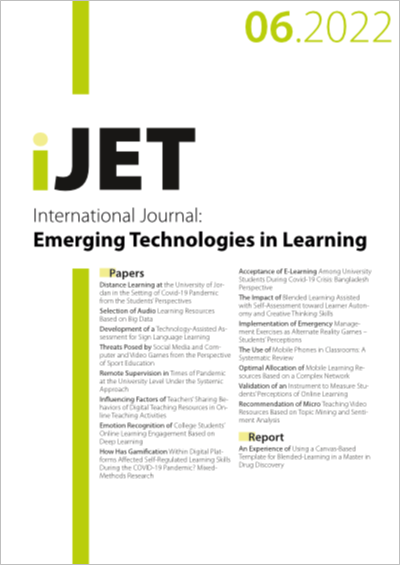Remote Supervision in Times of Pandemic at the University Level Under the Systemic Approach
DOI:
https://doi.org/10.3991/ijet.v17i06.27941Keywords:
Covid-19, maltese cross, remote supervision, soft systems, systemic approach, universityAbstract
In this research work, the remote supervision of teachers is shown to be carried out within the framework of Covid-19 at the University of Sciences and Humani-ties, where full and part-time teachers and also students had training in the use of digital tools for the development of their digital skills and competencies. Howev-er, teachers and students had limitations in connectivity and the minimum condi-tions such as the use of PCs or smartphones for the realization of the classes. The soft systems and the Wilson methodologies were used with a systemic approach, based on its Maltese cross where information was obtained on the perception of the teaching-learning process in remote time by the student, teacher, assistant, co-ordinator of the area, teaching assistant who were directly involved in the super-vision of remote classes. The objective of the article is to make a proposal for continuous improvement in remote learning teaching in times of pandemic. The result obtained from the research was that remote supervision allowed the teach-ing-learning process to be improved by providing feedback on continuous im-provement. It is concluded that the supervision of teachers requires teachers of full time, as well as more training in the use of digital tools, benefiting students from research.
Downloads
Published
2022-03-29
How to Cite
Andrade-Arenas, L., Yon Alva, R., Vargas Vargas, G., & Príncipe Somoza, Y. (2022). Remote Supervision in Times of Pandemic at the University Level Under the Systemic Approach. International Journal of Emerging Technologies in Learning (iJET), 17(06), pp. 73–94. https://doi.org/10.3991/ijet.v17i06.27941
Issue
Section
Papers
License
Copyright (c) 2022 Laberiano Andrade-Arenas, Roberto Yon Alva, Roberto Yon Alva, Gilder Vargas Vargas, Gilder Vargas Vargas, Yrma Príncipe Somoza, Yrma Príncipe Somoza

This work is licensed under a Creative Commons Attribution 4.0 International License.


